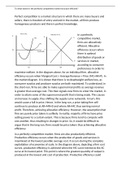To what extent is the perfectly competitive market structure efficient?
Perfect competition is a market structure in which there are many buyers and
sellers, there is freedom of entry and exit in the market, all firms produce
homogenous products and there is perfect knowledge.
In a perfectly
competitive market,
firms are allocatively
efficient. Allocative
efficiency occurs when
there is optimal
distribution of goods or
services in market,
according to consumer
preferences in order to
maximise welfare. In the diagram above, for an individual firm, allocative
efficiency occurs when Marginal Cost = Average Revenue = Price (MC=AR=P). In
the market diagram, it is shown that there is no deadweight welfare loss, as
consumer surplus and producer surplus are both maximized. To understand, in
the short-run, firms are able to make supernormal profits as average revenue
is greater than average cost. This then signals new firms to enter the market, in
order to attain some of the supernormal profit that is being made. This causes
an increase in supply, thus shifting the supply curve outwards. In turn, this
would cause a fall in price. Hence, in the long run, a price taking firm will
continue to produce at AR=MR=D and where AR=MC thus earning normal
profit. Therefore, achieving allocative efficiency. However, the assumption that
firm are purely price takers is unlikely. In reality, majority of firms have price
setting power to a certain extent. This is because firms tend to compete with
one another, thus resulting in changes in price. So, it would be difficult to
argue that in the long-run, firms would be price takers thus achieving allocative
efficiency.
In a perfectly competitive market, firms are also productively efficient.
Productive efficiency occurs when the production of goods and services is
maximised at the lowest possible average cost. It occurs during the complete
exploitation of economies of scale. In the diagram above, depicting a firm cost
curves, productive efficiency is achieved when the MC curve intersects the AC
curve at its lowest point. This point is where the greatest quantity of output is
produced at the lowest unit cost of production. Productive efficiency could




